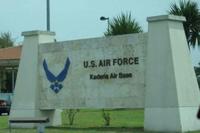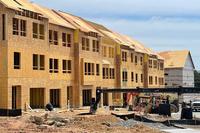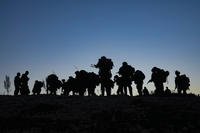Hawaii may be in line to see more spending on military construction in the next fiscal year than any other state after the U.S. House Appropriations committee recently passed its version of a military construction spending bill with $1.55 billion slated for Hawaii projects.
“By allocating fully 8 % of our total national and worldwide military construction budget to Hawaii, we are making a generational reinvestment in Hawaii in the critical facilities we need to meet the challenges of the Indo-Pacific, ” said U.S. Rep. Ed Case, who serves on the committee.
Hawaii is home to U.S. Indo-Pacific Command, which oversees all U.S. military operations across the Pacific and much of Asia—the Pentagon’s top priority theater of operations amid tensions with China and North Korea.
Both Hawaii elected leaders and contractors have been keen to rake in defense dollars, particularly after the COVID pandemic devastated the state’s tourism-dependent economy. Defense spending stayed relatively steady during the pandemic. And although tourists have made their way back, some Hawaii leaders see the military as a pathway to diversifying the islands’ economy.
“It’s not just about construction, ” said Jason Chung, the vice president of the Hawaii Chamber of Commerce’s Military Affairs Council. “It’s about the different jobs and careers and diversification and opportunity to keep Hawaii’s talent here in Hawaii. Because along with construction comes a whole bunch of ancillary jobs.”
Not everyone shares that excitement.
“I believe, quite frankly, we should shrink our military footprint, not expand it, ” former Hawaii Senate majority leader Gary Hooser, who now serves as president of the Hawaii Alliance for Progressive Action, told the Honolulu Star-Advertiser.
While the military is helping to prop up Hawaii’s economy, countless dollars have also been spent over decades on cleaning up pollution associated with the military presence. In particular, the Red Hill water crisis—which began in 2021 when jet fuel from the Navy’s underground Red Hill storage facility tainted the area’s water system serving 93, 000 people—has put military operations in Hawaii under the microscope.
Heightened scrutiny of the military’s large presence in the state has spurred the Hawaiian sovereignty movement and associated groups to call for the military to scale back its footprint—or leave altogether.
“I believe in a strong defense—my father was career military man, I have lots of friends and family in the military ; I’m not anti-military, ” Hooser said. But he added that “the military has not been good stewards of the land and the water. It will take generations to clean up after they leave, as Kahoolawe shows clearly, for Pohakuloa the same way, and with other locations. When they leave, which I hope is soon, the cleanup will take generations.”
Big spending The biggest share of the potential funds for Hawaii military construction—$1.2 billion—would go to the Pearl Harbor Naval Shipyard for Dry Dock 5, which is the single most expensive construction project in the U.S. Navy’s history.
It’s expected to cost at least $3.4 billion when it’s completed in 2028, not including upkeep, maintenance and operations costs. It will replace the current Dry Dock 3, which will become functionally obsolete once the Navy retires the last of its Los Angeles-class submarines. Built in 1942, Dry Dock 3 is unable to service the Navy’s newer Virginia-class submarines or larger surface ships.
The proposed expenditures come as the mood in the Pacific is tense. China has become embroiled in bitter disputes with neighboring countries over maritime territorial and navigation rights. That’s especially true in the South China Sea, a busy waterway through which as much as a third of all international trade travels and where tensions have sometimes boiled over into violent confrontations.
Beijing claims nearly the entire waterway as its exclusive territory over its neighbors’ objections.
Meanwhile, the U.S. military has been conducting near-constant “freedom of navigation ” operations in the Pacific over China’s objections. The constant operations have been demanding on the Navy’s fleets. The U.S. military sees Pearl Harbor’s shipyard as a key repair and logistics hub to keep the fleets running.
The yard is also Hawaii’s top industrial employer with over 6, 000 employees.
U.S. Rep. Jill Tokuda, who serves on the House Armed Services Committee, said, “I want local companies and local workers to benefit from the billions of dollars that have been and will be pouring into our state for (military construction ) and for other infrastructure needs for the Indo-Pacific. And that’s a big priority for me.”
Chung said that beyond industrial work, the new facilities are “going to need a lot of IT infrastructure and cybersecurity to be able to continue to kind of improve and optimize the maintenance of the fleet, and how critical it is.”
Technological advancements are rapidly changing how the military operates—as well as what it needs.
“Historically, what’s really interesting, is the No. 1 industry has always been military construction and engineering services, which kind of makes sense, ” he said. “But two years ago, that was eclipsed by professional services and what we’re seeing is this emerging industry of information technology, cybersecurity, data science, business analytics and intelligence.”
Those changing numbers have caught attention of state leaders.
In 2021 the state Department of Business, Economic Development & Tourism helped launch the Hawaii Defense Alliance, which brings together industry executives, government officials and academics to connect local companies with defense contracts. In March, DBEDT established a new Military and Community Relations office with a $3.2 million grant from the Pentagon’s Office of Local Defense Community Cooperation.
Officials hope an influx of defense dollars will allow Hawaii to grow the type of tech jobs that many local graduates have been leaving home to pursue on the continental U.S.
Critics of plans to solidify the military’s footprint in Hawaii argue that rather than weaning the state off its tourism dependency, it simply entrenches a different kind of dependency.
“This is not diversification, ” said Hooser. “It’s not sustainable ; it ends up being a dependency on the federal government’s federal money. If we want true diversification, we’d look at agriculture, for example.”
While the military construction bill would set records for Hawaii in the next fiscal year, it also would include several cuts.
House Republicans, some of whom argue that climate change is not a national security concern, fought to cut spending on programs to protect military installations from rising sea levels and intensifying weather, as well as several environmental clean-up efforts.
Case, a Democrat, said in a statement, “while the measure funds many critical national, Indo-Pacific and Hawaii priorities for our military infrastructure and veterans which I support, I regrettably had to vote against the measure overall because it reduces funding far below what is needed, including $1.5 billion in cuts to critical military construction projects, shortchanges dedicated funding for Per-and polyfluoroalkyl substances (PFAS ) cleanup, eliminates climate and military base resiliency efforts, rejects important VA infrastructure funding and rejects diversity advancement initiatives.”
It’s likely the final version of the legislation will see changes as it goes through the Senate, where Democrats hold a slim majority. But environmental issues have become an increasingly serious problem for military leaders in Hawaii as they face an increasingly skeptical public—especially since the 2021 Red Hill spill.
The military is dealing with increased scrutiny across the islands. The Air Force recently announced it is working in conjunction with the Space Force and the Air Force Research Laboratory to build up to seven new telescopes atop Haleakala to track space debris. The plan has drawn pushback, with some opponents noting that the military has yet to finish remediation of the 700-gallon diesel spill on Haleakala in January 2022.
On June 5, the Maui County Council passed a resolution opposing the proposed telescopes. The resolution stated, “Haleakala is more than just a mountain ; the summit is considered wao akua, or ‘realm of the gods, ’ and continues to be a place of deep spirituality for Native Hawaiians to engage in some of these traditional practices.”
RimPac returns Meanwhile, the U.S. Pacific Fleet is gearing up for its biennial Rim of the Pacific Exercise, which is expected to bring 40 warships, three submarines, over 150 aircraft and 25, 000 personnel from 29 countries to train in and around the islands.
Ships are making their way to Hawaii as tensions in the Pacific ramp up.
Last week a Philippine Navy sailor was seriously injured during what the Philippines described as a an “intentional high-speed ramming ” by the Chinese Coast Guard of one of its boats that was resupplying an outpost in disputed territory.
White House National Security Council spokesperson John Kirby told journalists on Monday that “this kind of behavior (by China ) is provocative, it’s reckless, it’s unnecessary, and it could lead to misunderstandings and miscalculations that could lead to something much bigger and much more violent.”
Hooser said Hawaii residents should be concerned about the increasingly dangerous situation in the Pacific and that there needs to be an effort to prevent war and seek peace. But he acknowledged that countries across the region have to buy into a diplomatic approach as well.
He argued there should be an effort to invest locally in institutions that promote diplomacy and peace, pointing to the Matsunaga Institute for Peace at the University of Hawaii, and a push to bring regional leaders to the table to talk.
“That’s where we should invest some money and revitalize now, (to make Hawaii ) into a real center of diplomacy, of peacemaking, a place where we can advise world leaders … and have those discussions reach conclusions that are win-win for all, ” he said.
Advocates for building up military capabilities in Hawaii argue that military investments are necessary alongside diplomatic efforts to maintain a balance that will prevent major conflicts in the region.
“No one wants conflict or war in this region, because it would be just totally devastating, ” said Chung. “And no one knows that more than folks who actually have gone to combat and war. The whole purpose of this is deterrence, to be able to deter conflict in this region and preserve the way of life and free trade within the Indo-Pacific.”
___
(c)2024 The Honolulu Star-Advertiser
Visit The Honolulu Star-Advertiser at www.staradvertiser.com
Distributed by Tribune Content Agency, LLC.












